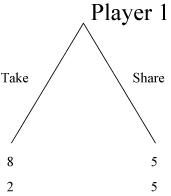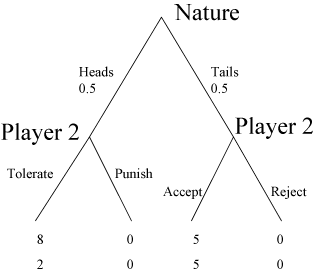|
|
|
|
Dictator Controls for Punishment-MUG Game |
|
Punishment-MUG Dictator Control 1 |
|
Punishment-MUG Dictator Control 1 is a dictator game in which player 1 chooses between Take and Share and player 2 has no decision to make. Player 1 does not have to be afraid of any possible punishment by the other player and can thus choose his preferred outcome. |
|
The Punishment-MUG Dictator Control 1 eliminates the possible motive of fear of negative reciprocity that might be present in player 1?s behavior when playing the original Punishment-MUG game. |
|
The Game |
|

|
|
Nash Prediction for Self-Regarding Preferences |
|
The unique Nash prediction for player 1 with selfish preferences is to choose ?Take? since it leads to higher monetary payoffs. |
|
Common Experimental Results |
|
The comparison of players? 1 decisions in the punishment-MUG game and the decisions in the Punishment Dictator Control 1 discriminates between choices of Share that are motivated by fear of negative reciprocity and choices that are motivated by non-reciprocal other-regarding preferences. |
|
In Cox and Deck [2002] 64% of players 1 chose Take in the original Punishment-MUG game and 70% chose Take in PDC1. This means that more participants of the experiment decided to chose the unequal decision when the paired player 2 did not have a chance to punish them than when this opportunity existed. From comparison of data one can conclude that first movers? behavior in the Punishment-MUG game is not characterized by fear of negative reciprocity. |
|
Punishment-MUG Dictator Control 2 |
|
Punishment-MUG Dictator Control 2 is a dictator game in which player 1 does not make a decision. The choice is determined by a random process when the strategies Take and Share can be selected with an equal probability. Since the situation player 2 is in was not chosen by player 1, player 2 has no reason to punish him. Thus the difference between player 2?s decision in the punishment-MUG game and Punishment Dictator Control 2 game discriminates between player 2?s choices of ($0, $0) outcome motivated by negative reciprocity and choices motivated by non-reciprocal inequality-averse preferences. |
|
The Punishment-MUG Dictator Control 2 eliminates the possible motive of negative reciprocity that might be present in players? behavior when playing the original Punishment-MUG game. |
|
The Game |
|

|
|
Nash Prediction for Self-Regarding Preferences |
|
Player 2 with self-regarding preferences prefers the strategies Tolerate to Punish when in the ?Take node? and Accept to Reject when in the ?Share node?. |
|
Common Experimental Results |
|
Let?s again look at Cox and Deck [2002] results. After being offered an unequal split only 21% of players 2 chose punish. This behavior can be described as negative reciprocity only if it is the case that players 2 prefer the outcome ($8, $2) to ($0, $0) when players 1 have not made any decision that would harm players 2. Only 3 out of 13 (23%) players 2 in PCD2 who hade to decide whether to Tolerate or Punish because of the outcome of the coin flip chose Punish. The difference in the behavior of players 2 in the Punishment-MUG game and PCD2 does not support the evidence of negative reciprocity in this experiment what is consistent with the expectations of players 1. |
|
Further Readings |
|
|
|
Page source: http://www.econport.org/econport/request?page=man_tfr_experiments_dictgame_punishment
|